Radical salvage: Mike Nelson at the Hayward Gallery
The mid-century brutalist hulk of London’s Hayward Gallery conceals a
storage site of architectural salvage, remains of the past packing the concrete
shell. However, as Paul Dobraszczyk discovers for recessed.space, this
is not a space of decay and detritus so much as an radical site of rebirth and
reimagination.
The most powerful installation in the Hayward Gallery’s current survey of the oeuvre of British artist Mike Nelson is a reconstruction of his 2001 work The Deliverance and the Patience. Originally exhibited inside an old brewery in Venice for the 2001 Biennale, it’s a self-contained structure composed of 16 rooms that references two 17th-century ships built to transport a community of shipwrecked castaways living on an island in Bermuda to their plantations in North America. Whilst stranded on the island, this group of indentured workers and prisoners established a utopian society before being forced by their masters – the Virginia Company – to build the ships on which they continued their journey to a far less rosy life of slave-labour.
In the same year that Nelson was building The Deliverance and the Patience, writer China Miéville was also dreaming up another ship-based fantasy, The Scar, the second in his celebrated Bas-Lag trilogy. Published in 2002, The Scar centred on an extraordinary floating city, named Armada, that had been created by a community of pirates. Miéville’s Armada is a floating metropolis, made up of hundreds of old ships tethered together with chains and bridges.
Miéville’s is a chaotic, hybrid architecture that is reflected in the social life of the city itself – fierily egalitarian, anarchic, and also distinctly masculine. Similar things might be said of The Deliverance and the Patience; yet its strange rooms are entirely deserted, the only sounds experienced by visitors are incessant creaking and banging of countless doors that divide the rooms and a whirring of overhead fans installed in some of them. It’s a meld of Miéville’s Armada and the Marie Celeste, as if a self-built seafaring city had become inexplicably beached in the austere concrete room of a Brutalist art gallery.
![]()
![]()
I don’t know if Nelson and Miéville have met, or whether there’s any direct link between their respective ‘pirate utopias’; but both were definitely influenced by Marcus Rediker’s book The Many-Headed Hydra: The Hidden History of the Revolutionary Atlantic (published in 2000) and an earlier study by Peter Lamborn Wilson, Pirate Utopias: Moorish Corsairs and European Renegades (1996). Wilson (who also went by the pseudonym Hakim Bey) saw in pirate communities an example of what he, in 1993, had termed Temporary Autonomous Zones. These are spaces and communities that operate outside of the dictates of social and economic norms: anarchist communes in effect that remake society from the bottom-up seemingly without reference to accepted social and political hierarchies.
Exploring the maze of rooms that is The Deliverance and the Patience is disconcerting because, here, you’re invited to actually inhabit spaces that only otherwise appear to us in the imagination as, for example, through fantasy novels like The Scar. As has often been noted in relation to Nelson’s work, there’s an overwhelming material presence to his pieces, made possible by an obsessive, even megalomaniacal repurposing of the material detritus left behind by the constant churn of capitalist production. In more restrained contexts, we might call this architectural salvage: a form of retro-chic that has become a marker of both aesthetic sophistication and ecological awareness.
![]()
![]()
Not so with Nelson. Entering the first installation in the Hayward Gallery, titled I, IMPOSTER and originally exhibited in 2003, is rather like visiting a subversive version of IKEA: in red darkroom light, you move around shelves stacked with all the materials Nelson scavenged to create his earlier work Magazin: Büyük Valide Han. This an artwork as literal architectural salvage: Nelson asks us to regard the spaces in which he stores his materials – both before and after creating his works – as vital elements of what it means to be an artist who makes works out of junk. This store is temporary, but Nelson has many places scattered around the UK and beyond in which he stores the colossal quantities of materials he’s gleaned over the years from flea-markets, auctions, skip, dumps, and car-boot sales.
Of course, making art out of rubbish is by no means a new thing – its founding moment arguably The Art of Assemblage exhibition in New York 1961 – but Nelson takes that practice to new levels, not only in terms of the sheer scale of his installations but also in the ways in which he takes us behind the scenes of that practice, showing us other kinds of spaces created when you end up collecting so much trash. This isn’t quite hoarding, but nevertheless something for more disturbing than pottering around an architectural salvage yard.
![]()
![]()
If there is a common theme to Extinction Beckons, it is precisely this insistence on the process of salvage as key to holding onto the past, whether that’s in the form of materials or memories. In another large-scale installation, Triple Bluff Canyon, what is salvaged is multiple. First, this is a reconstituted version of itself – like The Deliverance and the Patience, Triple Bluff Canyon was first created elsewhere, shown at Modern Art Oxford in 2004. Second, it’s a reconstituted version of Robert Smithson’s 1970 work Partially Buried Woodshed, with sand rather than soil used to bury the wooden structure.
In its present incarnation, Triple Bluff Canyon also features a mysterious domed space, buried under the sand and accessed through a narrow, curving corridor. This is a deeply unnerving darkroom, its dim red light revealing weird objects and photographic prints hanging out to dry. Perhaps nowhere else in the exhibition is the feeling of stumbling across a post-apocalyptic film set quite as powerful as it is here. The layers of materiality, inside and out, offer a literal, if highly inscrutable, rendering of Nelson’s artistic practice itself, as well as something of his mental world, steeped as it is in the science-fiction of Stanisław Lem, Arkady and Boris Strugatsky, and J. G. Ballard.
![]()
More recently, Nelson has used salvage to create very different kinds of artworks, represented here by The Asset Strippers. These five monumental sculptures are made from defunct industrial and agricultural machinery and associated objects, purchased by Nelson through online auctions. The Asset Strippers was first exhibited in 2019 in the Duveen Galleries of Tate Britain, as part of the gallery’s ongoing series of commissions to respond to this grand space of display. Reconfigured in the Hayward, these sculptures possess a dignified stillness in their evocations of Britain’s industrial past, particularly the textile manufacturing that once employed some of Nelson’s family members in the places where he grew up in the East Midlands.
Yet, the title The Asset Strippers suggests violent displacement, the phrase itself meaning the brutal economic practice of selling off a company’s assets to improve returns for equity investors. Is Nelson himself the asset stripper here? If he is, what exactly is he stripping away, and who is set to benefit from his actions? Salvage, here, is given a pointedly political meaning. These sculptures are no longer assets in any conventional sense of the word, unless of course we mean aesthetic ones; for these sculptures are most definitely not for sale.
![]()
![]()
Taken as a whole, Extinction Beckons exhibit an intoxicating and bewildering display of the artistic and architectural possibilities of salvage. If we are inclined towards a romantic attitude towards slums – as architects like John Turner were in the 1970s – we might regard Nelson as a master self-builder, doing extraordinarily creative things with the detritus of capitalism. Yet his works are much more disquieting than elaborate self-builds. They have a strong political bite because they suggest that the meanings of objects in the world can change at any time, but also that this process of reconstitution requires hard and dirty work.
It’s no accident that the journal that China Miéville co-founded in 2015 is called Salvage. A product of his and others’ perceived disenfranchisement of the radical left in contemporary Britain, the journal’s apocalyptic tone and strident Marxist agenda reflect something of Nelson’s own practice of salvage. As writer and artist Evan Calder Williams argued in his 2011 book Combined and Uneven Apocalypse, radical salvage insists that “there is no new construction, just the occupation of other architectures.” The residues we see in Nelson’s work – and there are far too many to process adequately in any review – indicate that not only is capitalism already in ruins, but that there is more than enough detritus already out there to build something else.
That Nelson’s work feels bleak – post-apocalyptic even – does not mean that it isn’t fundamentally optimistic. Extinction may be an idea that terrifies us, but it can also beckon us towards the truth of our situation, bleak as that may be. Only in the light of truth can the hard work of making something more meaningful – more sustainable even, if we’re lucky – begin. We may be rightly disgusted by the unholy mess that humans as a whole have created; but only by accepting it, like Nelson, can we begin the arduous task of re-making it into something better.
![]()
![]()
In the same year that Nelson was building The Deliverance and the Patience, writer China Miéville was also dreaming up another ship-based fantasy, The Scar, the second in his celebrated Bas-Lag trilogy. Published in 2002, The Scar centred on an extraordinary floating city, named Armada, that had been created by a community of pirates. Miéville’s Armada is a floating metropolis, made up of hundreds of old ships tethered together with chains and bridges.
Miéville’s is a chaotic, hybrid architecture that is reflected in the social life of the city itself – fierily egalitarian, anarchic, and also distinctly masculine. Similar things might be said of The Deliverance and the Patience; yet its strange rooms are entirely deserted, the only sounds experienced by visitors are incessant creaking and banging of countless doors that divide the rooms and a whirring of overhead fans installed in some of them. It’s a meld of Miéville’s Armada and the Marie Celeste, as if a self-built seafaring city had become inexplicably beached in the austere concrete room of a Brutalist art gallery.
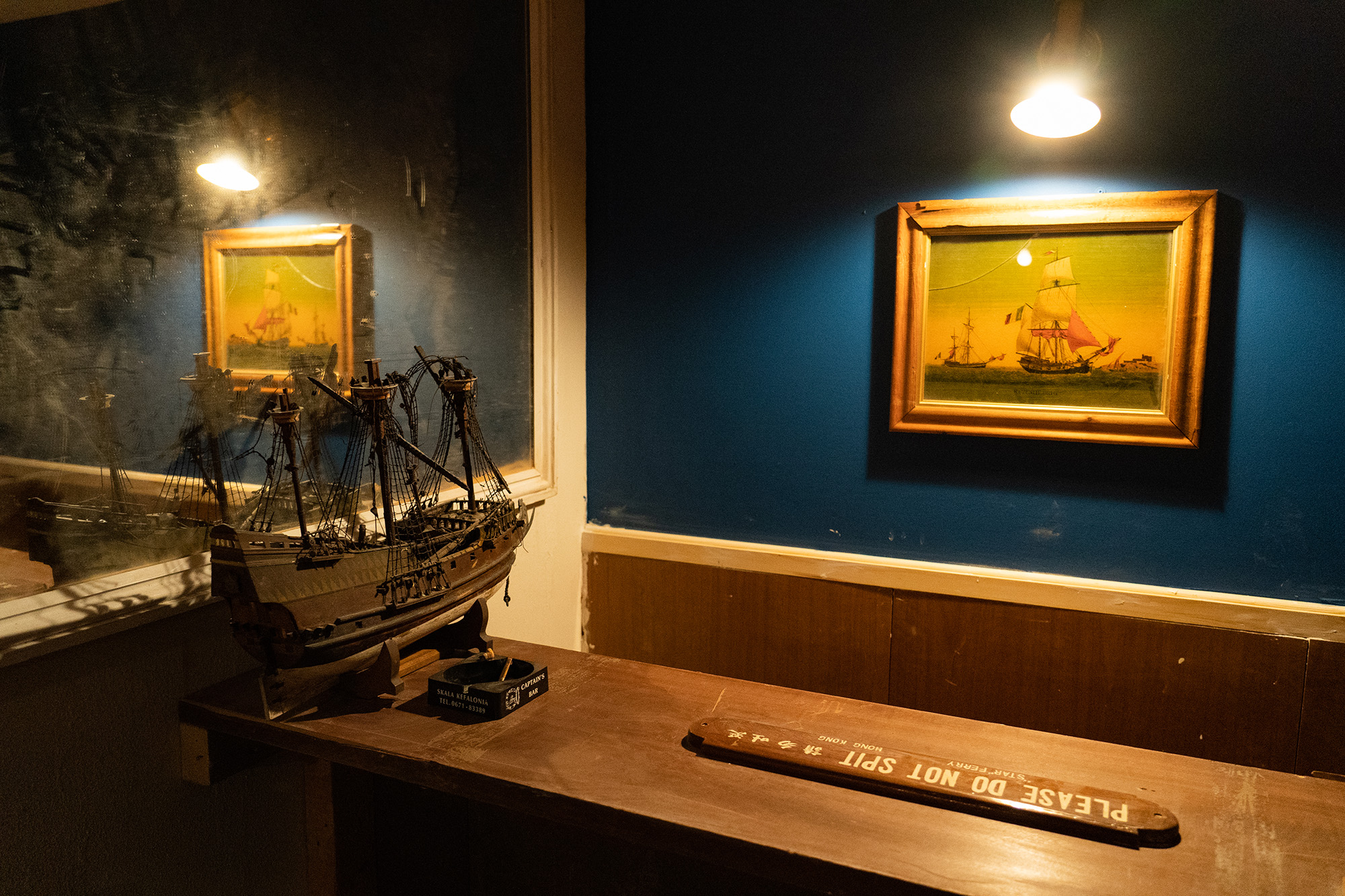

fig.i,ii
I don’t know if Nelson and Miéville have met, or whether there’s any direct link between their respective ‘pirate utopias’; but both were definitely influenced by Marcus Rediker’s book The Many-Headed Hydra: The Hidden History of the Revolutionary Atlantic (published in 2000) and an earlier study by Peter Lamborn Wilson, Pirate Utopias: Moorish Corsairs and European Renegades (1996). Wilson (who also went by the pseudonym Hakim Bey) saw in pirate communities an example of what he, in 1993, had termed Temporary Autonomous Zones. These are spaces and communities that operate outside of the dictates of social and economic norms: anarchist communes in effect that remake society from the bottom-up seemingly without reference to accepted social and political hierarchies.
Exploring the maze of rooms that is The Deliverance and the Patience is disconcerting because, here, you’re invited to actually inhabit spaces that only otherwise appear to us in the imagination as, for example, through fantasy novels like The Scar. As has often been noted in relation to Nelson’s work, there’s an overwhelming material presence to his pieces, made possible by an obsessive, even megalomaniacal repurposing of the material detritus left behind by the constant churn of capitalist production. In more restrained contexts, we might call this architectural salvage: a form of retro-chic that has become a marker of both aesthetic sophistication and ecological awareness.
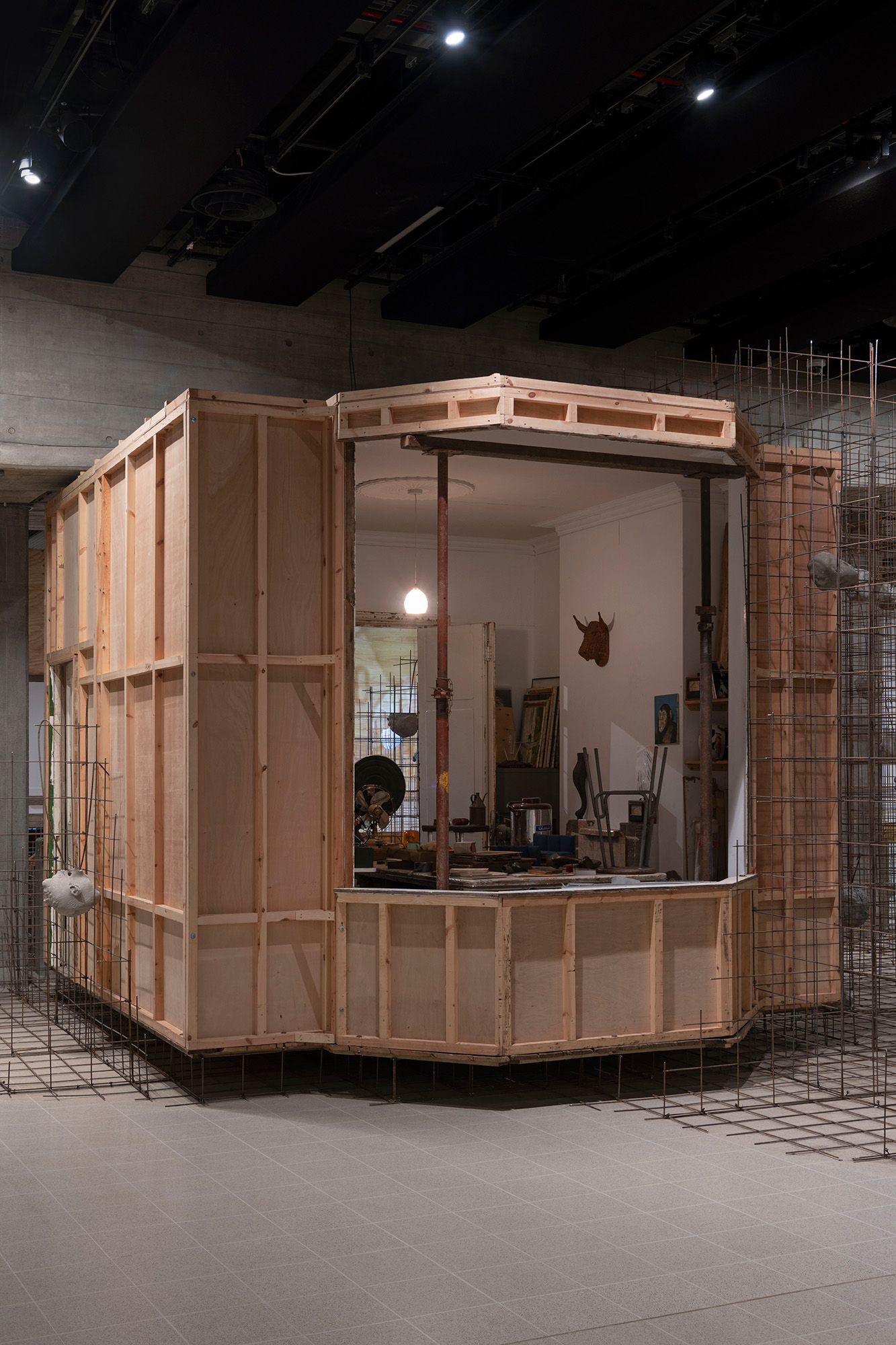
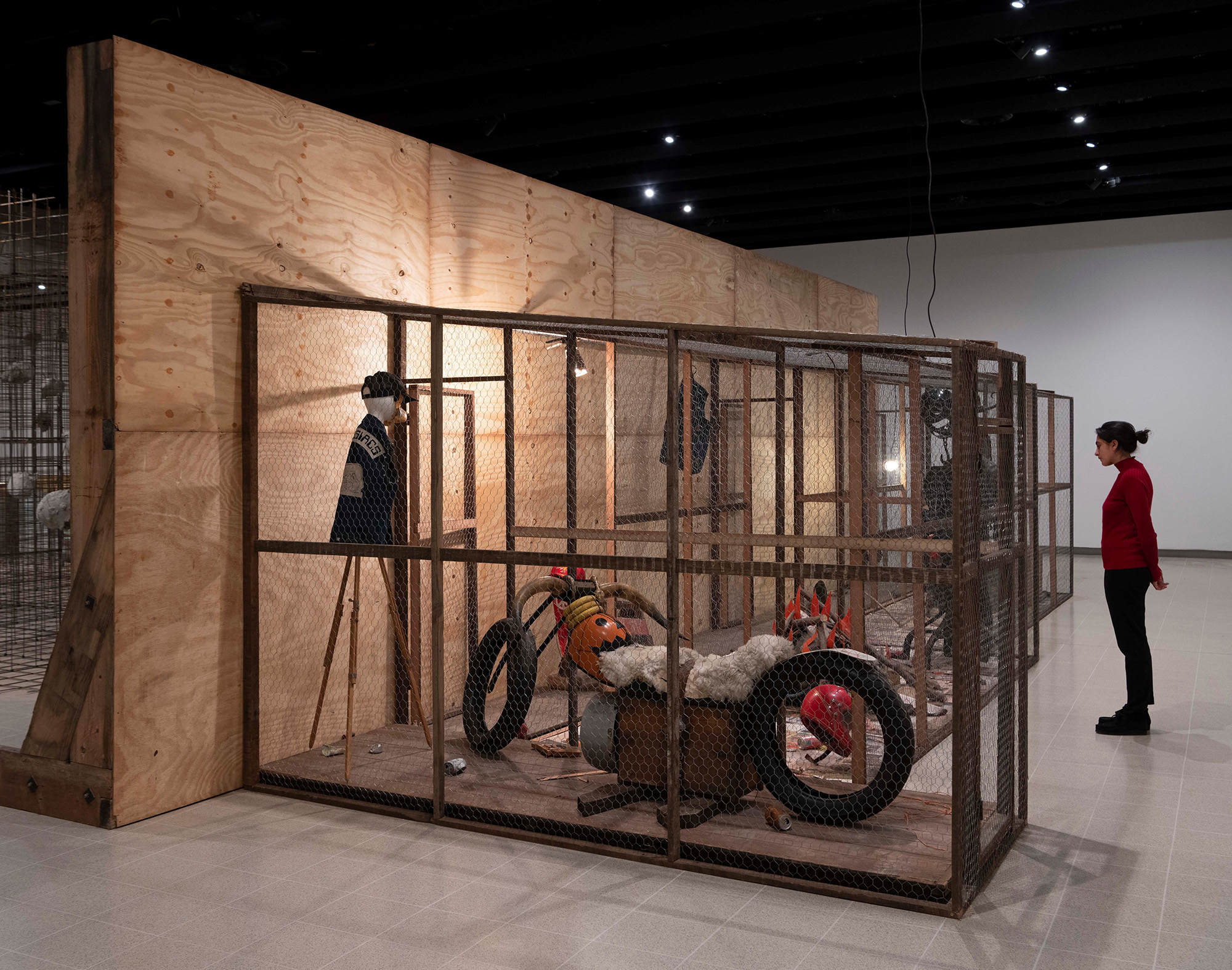
fig.iii,iv
Not so with Nelson. Entering the first installation in the Hayward Gallery, titled I, IMPOSTER and originally exhibited in 2003, is rather like visiting a subversive version of IKEA: in red darkroom light, you move around shelves stacked with all the materials Nelson scavenged to create his earlier work Magazin: Büyük Valide Han. This an artwork as literal architectural salvage: Nelson asks us to regard the spaces in which he stores his materials – both before and after creating his works – as vital elements of what it means to be an artist who makes works out of junk. This store is temporary, but Nelson has many places scattered around the UK and beyond in which he stores the colossal quantities of materials he’s gleaned over the years from flea-markets, auctions, skip, dumps, and car-boot sales.
Of course, making art out of rubbish is by no means a new thing – its founding moment arguably The Art of Assemblage exhibition in New York 1961 – but Nelson takes that practice to new levels, not only in terms of the sheer scale of his installations but also in the ways in which he takes us behind the scenes of that practice, showing us other kinds of spaces created when you end up collecting so much trash. This isn’t quite hoarding, but nevertheless something for more disturbing than pottering around an architectural salvage yard.

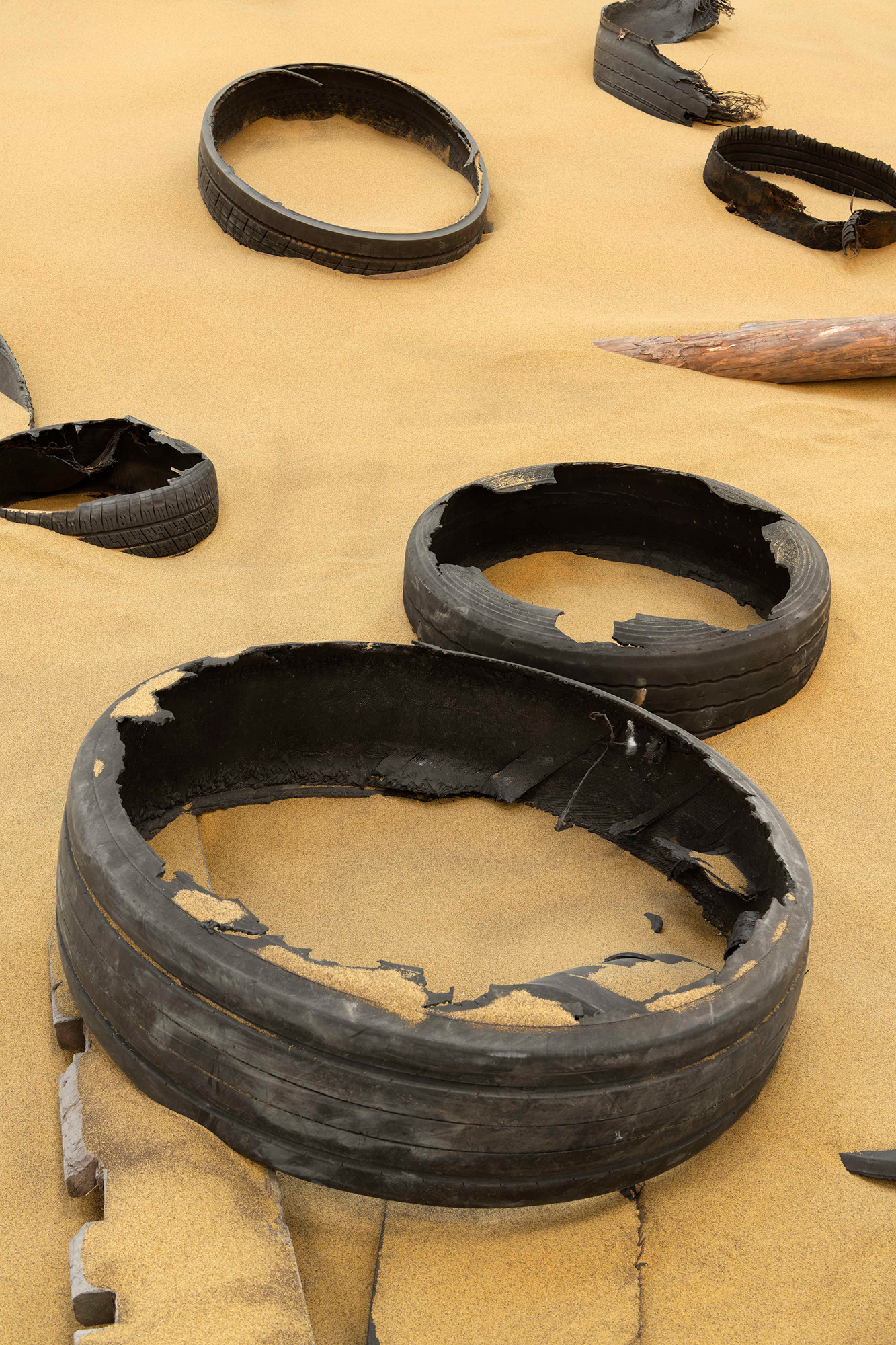
fig.v,vi
If there is a common theme to Extinction Beckons, it is precisely this insistence on the process of salvage as key to holding onto the past, whether that’s in the form of materials or memories. In another large-scale installation, Triple Bluff Canyon, what is salvaged is multiple. First, this is a reconstituted version of itself – like The Deliverance and the Patience, Triple Bluff Canyon was first created elsewhere, shown at Modern Art Oxford in 2004. Second, it’s a reconstituted version of Robert Smithson’s 1970 work Partially Buried Woodshed, with sand rather than soil used to bury the wooden structure.
In its present incarnation, Triple Bluff Canyon also features a mysterious domed space, buried under the sand and accessed through a narrow, curving corridor. This is a deeply unnerving darkroom, its dim red light revealing weird objects and photographic prints hanging out to dry. Perhaps nowhere else in the exhibition is the feeling of stumbling across a post-apocalyptic film set quite as powerful as it is here. The layers of materiality, inside and out, offer a literal, if highly inscrutable, rendering of Nelson’s artistic practice itself, as well as something of his mental world, steeped as it is in the science-fiction of Stanisław Lem, Arkady and Boris Strugatsky, and J. G. Ballard.
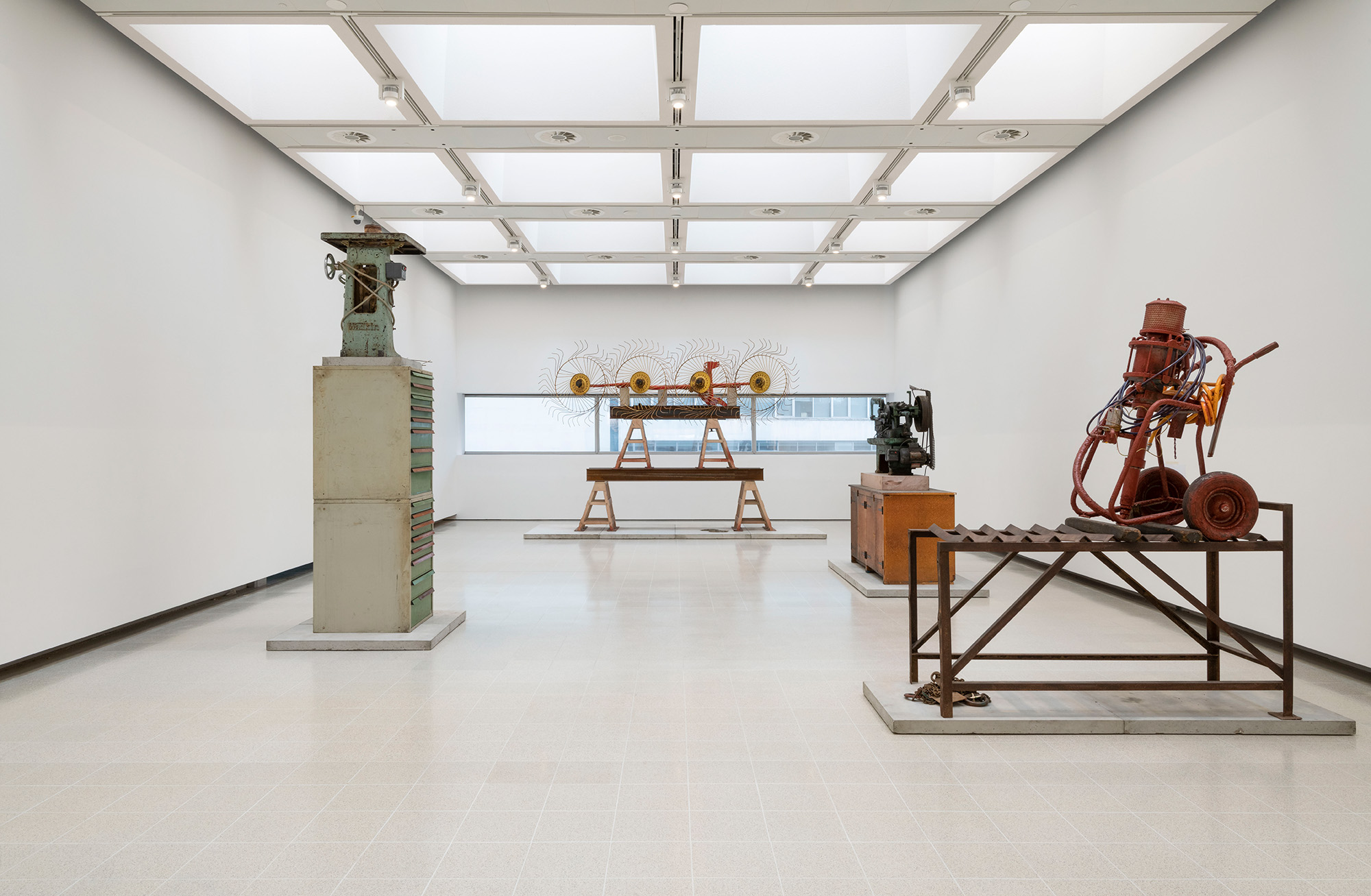
fig.vii
More recently, Nelson has used salvage to create very different kinds of artworks, represented here by The Asset Strippers. These five monumental sculptures are made from defunct industrial and agricultural machinery and associated objects, purchased by Nelson through online auctions. The Asset Strippers was first exhibited in 2019 in the Duveen Galleries of Tate Britain, as part of the gallery’s ongoing series of commissions to respond to this grand space of display. Reconfigured in the Hayward, these sculptures possess a dignified stillness in their evocations of Britain’s industrial past, particularly the textile manufacturing that once employed some of Nelson’s family members in the places where he grew up in the East Midlands.
Yet, the title The Asset Strippers suggests violent displacement, the phrase itself meaning the brutal economic practice of selling off a company’s assets to improve returns for equity investors. Is Nelson himself the asset stripper here? If he is, what exactly is he stripping away, and who is set to benefit from his actions? Salvage, here, is given a pointedly political meaning. These sculptures are no longer assets in any conventional sense of the word, unless of course we mean aesthetic ones; for these sculptures are most definitely not for sale.

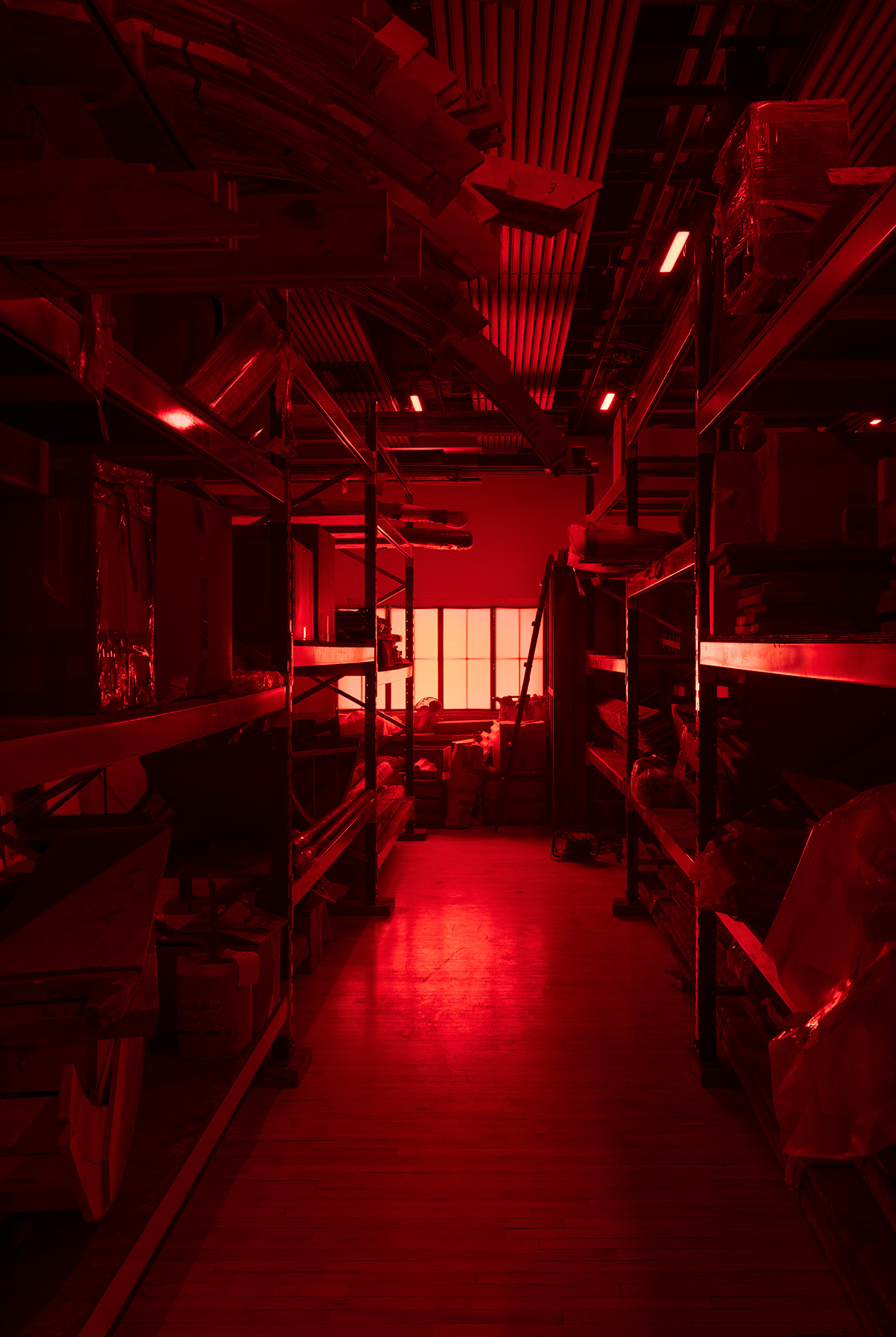
fig.viii,ix
Taken as a whole, Extinction Beckons exhibit an intoxicating and bewildering display of the artistic and architectural possibilities of salvage. If we are inclined towards a romantic attitude towards slums – as architects like John Turner were in the 1970s – we might regard Nelson as a master self-builder, doing extraordinarily creative things with the detritus of capitalism. Yet his works are much more disquieting than elaborate self-builds. They have a strong political bite because they suggest that the meanings of objects in the world can change at any time, but also that this process of reconstitution requires hard and dirty work.
It’s no accident that the journal that China Miéville co-founded in 2015 is called Salvage. A product of his and others’ perceived disenfranchisement of the radical left in contemporary Britain, the journal’s apocalyptic tone and strident Marxist agenda reflect something of Nelson’s own practice of salvage. As writer and artist Evan Calder Williams argued in his 2011 book Combined and Uneven Apocalypse, radical salvage insists that “there is no new construction, just the occupation of other architectures.” The residues we see in Nelson’s work – and there are far too many to process adequately in any review – indicate that not only is capitalism already in ruins, but that there is more than enough detritus already out there to build something else.
That Nelson’s work feels bleak – post-apocalyptic even – does not mean that it isn’t fundamentally optimistic. Extinction may be an idea that terrifies us, but it can also beckon us towards the truth of our situation, bleak as that may be. Only in the light of truth can the hard work of making something more meaningful – more sustainable even, if we’re lucky – begin. We may be rightly disgusted by the unholy mess that humans as a whole have created; but only by accepting it, like Nelson, can we begin the arduous task of re-making it into something better.

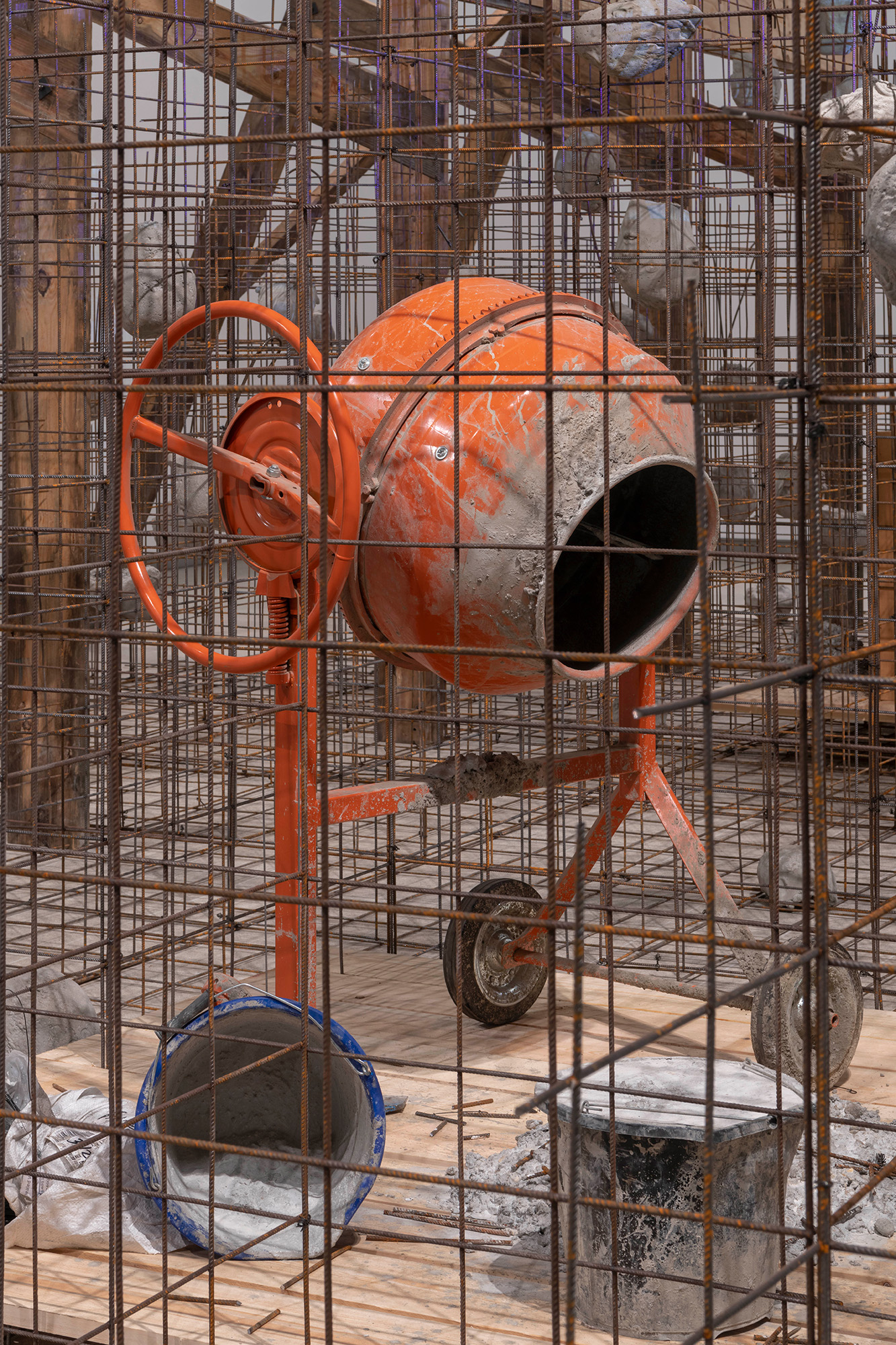
fig.x,xi
Paul Dobraszczyk is a Manchester-based writer and lecturer at the
Bartlett School of Architecture, London. He's the author of many books, the
most recent being Animal Architecture: Beasts, Buildings and Us(Reaktion, 2023) and Architecture and Anarchism: Building Without Authority (Paul Holberton, 2021) (as featured in recessed.space 007). He built the photographic website
stonesofmanchester.com in 2018.
www.ragpickinghistory.co.uk
Mike Nelson (b. Loughborough, UK, 1967) lives and works in
London. Nelson represented Britain at the Venice Biennale in 2011 & has
twice been nominated for the Turner Prize (2001; 2007).
Solo exhibitions & projects
include: The Book of Spells, (a speculative fiction), Matt’s Gallery,
London (2022); The House of the Farmer, Palazzo dell’agricoltore, Parma
(2021); The Asset Strippers, Tate Britain Commission, London (2019); L’Atteso,
Officine Grandi Riparazioni (OGR), Turin (2018); Cloak of rags (Tale of a
dismembered bank, rendered in blue), Galleria Franco Noero, Turin (2017); tools
that see (possessions of a thief) 1985-2005, neugerriemschneider, Berlin
(2016); Cloak, Noveau Musee National de Monaco, Monaco (2016); Imperfect
geometry for a concrete quarry, Kalkbrottet, Limhamn, Malmö, Sweden (2016);Amnesiac Shrine or The Misplacement... Museum Boijmans Van Beuningen,
Rotterdam (2016); Gang of Seven, 303 Gallery, New York (2015); Studio
apparatus for Kunsthalle Münster, Kunsthalle Münster (2014); Eighty
Circles through Canada, Tramway, Glasgow (2014); Amnesiac Hide, The
Powerplant, Toronto (2014); Amnesiac Hide, Contemporary Art Gallery,
Vancouver (2013); More things (To the memory of Honoré de Balzac),
Matt’s Gallery, London (2013); M6, Eastside Projects, Birmingham, UK
(2013); space that saw (platform for a performance in two parts) neugerriemschneider,
Berlin (2012); 408 tons of imperfect geometry, Malmö Konsthall, Malmö,
Sweden (2012); I, IMPOSTOR, British Pavilion, 54th Biennale di Venezia
(2011); Quiver of Arrows, 303 Gallery, New York (2010); A Psychic
Vacuum, Creative Time, New York (2007); AMNESIAC SHRINE or Double coop displacement,
Matt’s Gallery, London (2006); Triple Bluff Canyon, Modern Art Oxford
(2004); Nothing is True. Everything is Permitted. ICA, London (2001); The
Deliverance and The Patience, a PEER Commission for the Venice Biennale
(2001); and The Coral Reef, Matt’s Gallery, London (2000).
Group exhibitions include: 13th Gwangju Biennale (2021); MaytoDay,
Gwangju (2020); 12th Gwangju Biennale (2018); 250th Summer
Exhibition, Royal Academy of Arts, London (2018); Wanderlust, the High
Line, New York (2016); 13th Biennale de Lyon (2015); INSIDE, Palais de
Tokyo, Paris (2014); September 11, MoMA PS1, New York (2011); Singapore
Biennale (2011); Altermodern, Tate Britain (2009); Psycho Buildings,
Hayward Gallery, London (2008); Eclipse: Art in a Dark Age, Moderna
Museet, Stockholm, Sweden (2008); Reality Check, Statens Museum for
Kunst, Copenhagen, Denmark (2008); Turner Prize, Tate Liverpool (2007); Frieze
Projects, Frieze Art Fair, London (2006); and Turner Prize, Tate
Britain, London (2001).
Mike Nelson is represented by 303 Gallery, New York; Galleria Franco
Noero, Turin; Matt’s Gallery, London; and neugerriemschneider, Berlin.
Solo exhibitions & projects include: The Book of Spells, (a speculative fiction), Matt’s Gallery, London (2022); The House of the Farmer, Palazzo dell’agricoltore, Parma (2021); The Asset Strippers, Tate Britain Commission, London (2019); L’Atteso, Officine Grandi Riparazioni (OGR), Turin (2018); Cloak of rags (Tale of a dismembered bank, rendered in blue), Galleria Franco Noero, Turin (2017); tools that see (possessions of a thief) 1985-2005, neugerriemschneider, Berlin (2016); Cloak, Noveau Musee National de Monaco, Monaco (2016); Imperfect geometry for a concrete quarry, Kalkbrottet, Limhamn, Malmö, Sweden (2016);Amnesiac Shrine or The Misplacement... Museum Boijmans Van Beuningen, Rotterdam (2016); Gang of Seven, 303 Gallery, New York (2015); Studio apparatus for Kunsthalle Münster, Kunsthalle Münster (2014); Eighty Circles through Canada, Tramway, Glasgow (2014); Amnesiac Hide, The Powerplant, Toronto (2014); Amnesiac Hide, Contemporary Art Gallery, Vancouver (2013); More things (To the memory of Honoré de Balzac), Matt’s Gallery, London (2013); M6, Eastside Projects, Birmingham, UK (2013); space that saw (platform for a performance in two parts) neugerriemschneider, Berlin (2012); 408 tons of imperfect geometry, Malmö Konsthall, Malmö, Sweden (2012); I, IMPOSTOR, British Pavilion, 54th Biennale di Venezia (2011); Quiver of Arrows, 303 Gallery, New York (2010); A Psychic Vacuum, Creative Time, New York (2007); AMNESIAC SHRINE or Double coop displacement, Matt’s Gallery, London (2006); Triple Bluff Canyon, Modern Art Oxford (2004); Nothing is True. Everything is Permitted. ICA, London (2001); The Deliverance and The Patience, a PEER Commission for the Venice Biennale (2001); and The Coral Reef, Matt’s Gallery, London (2000).
Group exhibitions include: 13th Gwangju Biennale (2021); MaytoDay, Gwangju (2020); 12th Gwangju Biennale (2018); 250th Summer Exhibition, Royal Academy of Arts, London (2018); Wanderlust, the High Line, New York (2016); 13th Biennale de Lyon (2015); INSIDE, Palais de Tokyo, Paris (2014); September 11, MoMA PS1, New York (2011); Singapore Biennale (2011); Altermodern, Tate Britain (2009); Psycho Buildings, Hayward Gallery, London (2008); Eclipse: Art in a Dark Age, Moderna Museet, Stockholm, Sweden (2008); Reality Check, Statens Museum for Kunst, Copenhagen, Denmark (2008); Turner Prize, Tate Liverpool (2007); Frieze Projects, Frieze Art Fair, London (2006); and Turner Prize, Tate Britain, London (2001).
Mike Nelson is represented by 303 Gallery, New York; Galleria Franco Noero, Turin; Matt’s Gallery, London; and neugerriemschneider, Berlin.
visit
Extinction Beckons by Mike Nelson is on at The Hayward Gallery, London,
until 7 May 2023. Further information available at:
www.southbankcentre.co.uk/whats-on/art-exhibitions/mike-nelson-extinction-beckons
images
fig.i
Installation view of Mike
Nelson, Triple Bluff Canyon (the
projection room), 2004. Various materials.
Photo: Matt Greenwood. Courtesy the artist and
the Hayward Gallery.
fig.ii
Installation view of Mike
Nelson, The Deliverance and The Patience,interior, 2001. Various
materials. Various materials. Photo: Liam Harrison. Courtesy the artist and the
Hayward Gallery.
fig.iii
Installation view of Mike
Nelson, Triple Bluff Canyon (the
projection room), 2004. Various materials.
Photo: Matt Greenwood. Courtesy the artist and
the Hayward Gallery.
fig.iv
Installation view of
Mike Nelson, The Amnesiacs, 1996-ongoing.
Various materials. Photo: Matt
Greenwood. Courtesy the artist and the Hayward Gallery.
fig.v
Installation view of
Mike Nelson, Triple Bluff Canyon (the
woodshed), 2004. Various materials. M25,2023. Found tyres. Photo: Matt
Greenwood. Courtesy the artist and the Hayward Gallery.
fig.vi
Installation view of
Mike Nelson, Triple Bluff Canyon (the
woodshed), 2004. Various materials. M25,2023. Found tyres. Photo: Matt
Greenwood. Courtesy the artist and the Hayward Gallery.
fig.vii
Installation view of Mike
Nelson, The Asset Strippers, 2019.
Various materials. Photo: Matt Greenwood. Courtesy the artist and the Hayward
Gallery.
fig.viii
Installation view of
Mike Nelson, Studio Apparatus for
Kunsthalle Münster - A Thematic Instalment Observing the Calendrical
Celebration of its Inception: Introduction; towards a linear understanding of
notoriety, power, and their interconnectedness; futurobjecs (misspelt);
mysterious island* *see introduction or Barothic shift, 2014. Various
materials. Photo: Matt Greenwood.
Courtesy the artist and the Hayward Gallery.
fig.ix
Installation view of Mike
Nelson, I, IMPOSTER, 2011. Various
materials. Photo: Matt Greenwood. Courtesy the artist and the Hayward Gallery.
fig.x
Mike Nelson. Photo:
Arnaud Mbaki. Courtesy the artist and the Hayward Gallery.
fig.xi
Installation view of Mike
Nelson, Studio Apparatus for Kunsthalle
Münster - A Thematic Instalment Observing the Calendrical Celebration of its
Inception: Introduction; towards a linear understanding of notoriety, power,
and their interconnectedness; futurobjecs (misspelt); mysterious island* *see
introduction or Barothic shift, 2014. Various materials. Photo: Matt Greenwood. Courtesy the
artist and the Hayward Gallery.
publication date
03 March 2023
tags
Asset strippers, JG Ballard, Hakim Bey, Capitalism, Decay, Paul
Dobraszczyk, Extinction, Extinction Beckons, Hayward Gallery, Industrial,
Industry, Installation, Stanisław Lem, Machinery, Marxism, China Miéville, Mike
Nelson, Pirates, Politics, Post-apocalyptic, Marcus Rediker, Ruin, Salvage, Sculpture,
Robert Smithson, Arkady and Boris Strugatsky, Temporary Autonomous Zones, John
Turner, Evan Calder Williams, Peter Lamborn Wilson
www.southbankcentre.co.uk/whats-on/art-exhibitions/mike-nelson-extinction-beckons


